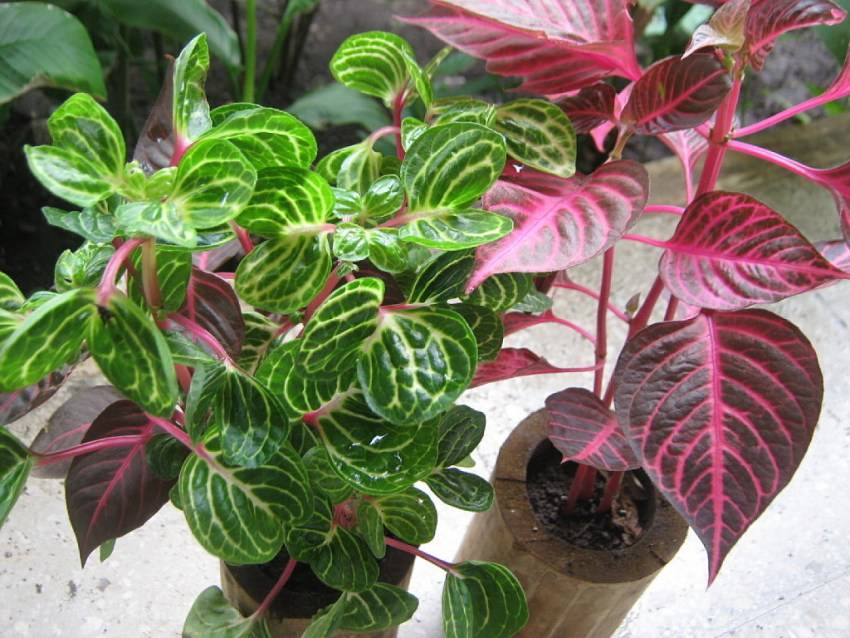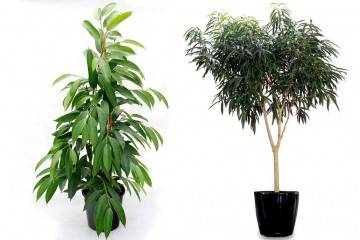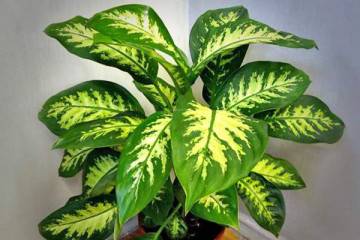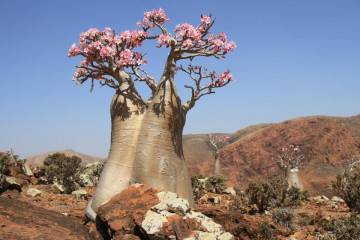Irezine flower - home care
Content:
Irezine is an ornamental deciduous plant. Its flowering is inconspicuous, the culture is valued only for its beautiful leaves. In summer, the plant can be grown in the garden, and in winter it can be brought indoors. Below is information about the conditions of detention, caring for irezin at home, breeding methods.
What does irezine look like
Under natural conditions, irezine grows in the USA, Australia, on islands in the Pacific Ocean. The culture belongs to the Amaranth family. The plant is a herbaceous erect bush, reaching a height of 60 cm.
The description says that the leaves of irezine are lanceolate, heart-shaped, or oval in shape. They are painted in various shades of green, red and purple.
Common varieties
At home, 2 types of irezine are cultivated: Herbst and Linden. The following varieties are most common:
- Aureoreticulata. Spectacular plant with emerald leaves, yellow or red veins;
- Briilliantissima. The plant is colored purple. The peculiarity of the variety is that the leaves of the culture are wrapped inward;
- Purple lady. Lady's Irezine Herbst Parple is painted in a deep purple palette;
- Lindenii Emersonii. The leaves of the culture are green with yellow veins, red petioles;
- Formosa. Irezine Linden Formosa is yellow-green with light veins.
All varieties of irezine are very decorative and are in great demand among flower growers.
Care features
In order for the culture to please with its spectacular appearance year-round, it must be properly looked after.
Temperature
In the summer, the plant develops well at a temperature of 20-25 ° C. If the weather is too hot and dry, the leaves will begin to lose turgor. In summer, flower growers practice growing irezine in the open ground of the garden. The flower must be accustomed to the air gradually. In winter, flower pots are kept at a temperature of 15-20 ° C.
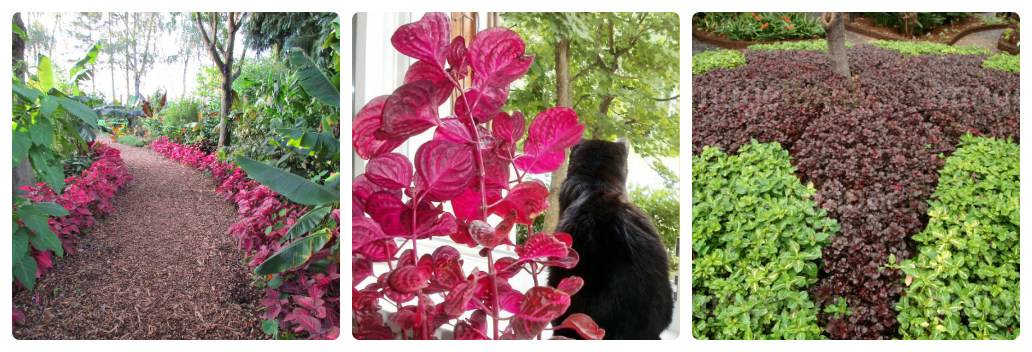
Irezine can be planted in the ground for the summer, and in the winter it can be dug up and kept in the house
Lighting
Irezine Herbstii is a light-loving culture, therefore, windows of southern, western, eastern orientation are selected for it. It should be borne in mind that the plant has delicate leaves, therefore, on a hot afternoon, it is covered from the sun's rays. Otherwise, burns may occur on the sheet plates.
Watering
Irezine is watered after the top layer of the substrate dries out. The water is used warm, settled. In winter, if the flower pots are kept in a cool room, watering is significantly reduced. Otherwise, the root system may start to rot due to excess moisture in the soil.
Spraying
During extreme heat, the bushes can be sprayed with water from a spray bottle. The procedure will help to increase the humidity in the air. In addition, dust will be washed off with water, which interferes with the respiration of the leaves.
Humidity
In winter, to increase the humidity of the air, a vessel with water is placed on the windowsill next to the plant.The culture will feel comfortable when placing the pot in a tray with moistened expanded clay.
Priming
The substrate is selected air and water permeable. At the flower shop, you can purchase a universal primer for ornamental plants. If possible, the florist can prepare the substrate on his own from the following components:
- garden land;
- leaf compost;
- peat;
- sand.
For disinfection, pieces of charcoal can be added to the soil.
Top dressing
To maintain a spectacular look, from spring to autumn, iresine is fed once every 7-14 days. Use a complex fertilizer for ornamental deciduous plants. In winter, the nutrient mixture is applied no more than 1 time per month.
Features of winter care
In the cold season, the irezine flower is kept at a temperature of 15-20 ° C. The bushes are watered much less frequently than in summer. In winter, there is a lack of sunlight, so the flower needs to be supplemented with artificial lamps. Fertilize the soil during this period once a month.
Pruning
Irezine is growing rapidly. In this case, the bush can stretch out, lose its decorative effect. To prevent this from happening, pruning is performed. The procedure is performed with a sharp, disinfected instrument.
Shoots are radically cut in the spring, leaving only foam. In this case, the cuttings can be rooted and new bushes can be grown. In the summer, pinch the tops, which contributes to the tillering of irezine.
How does it multiply
At home, irezine can be propagated by seeds and cuttings. The first method is rarely used because of its laboriousness. It is usually used by breeders to develop new varieties of crops. The peculiarity of seed reproduction is that some maternal traits may not appear in new plants.
Germinating seeds
Seed material is purchased at a flower shop. It is wrapped in cheesecloth, which is moistened with water daily. When the seeds hatch, sowing is carried out in a box filled with peat. They are buried 0.5 cm, cover the container with foil or glass.
Crop care consists in watering, airing a mini-greenhouse. When shoots appear, the shelter is removed. When 3-4 leaves appear, the plants are transplanted into small containers. Young bushes are kept in the same conditions as adult flowers.
Rooting cuttings
In spring, the bushes rejuvenate by cutting off cuttings. The branches can not be thrown away, but root and grow new flowers. The rooting procedure is performed as follows:
- Cut the cuttings about 10 cm long.
- Remove the lower leaves.
- Sections are dusted with growth enhancer powder.
- They are planted in boxes filled with wet sand.
- Cover with foil in such a way that the shelter does not touch the cuttings.
Every day, the film must be opened, wiped off condensation, and the plantings must be ventilated. The signal that the cuttings have taken root will be the appearance of roots and young shoots. After that, the plants are transplanted into separate pots.
Some growers, after cutting, cuttings are first placed in a glass of water and only after the roots appear, are they planted in containers.
Transfer
2 weeks after the purchase of the indoor flower irezina, a transplant is required. This must be done, because the plants are planted during transportation in a special low-fertile soil. Transplant the flower into a slightly larger pot.
In the future, the procedure is performed once every 2-3 years. The transplant is performed as follows:
- At the bottom of the pot, drainage is laid out from small stones, broken shards, expanded clay.
- A third is filled with fertile soil.
- Irezine is taken out of the container and placed with a lump of earth in the middle of a new pot.
- The space between the root system and the walls of the container is filled with a substrate.
The flower is watered, the pot is placed in a well-lit place.
Diseases and pests
Irezine can be affected by various diseases and pests. This happens for several reasons: improper care, planting a plant in contaminated land. Bushes can suffer from the following misfortunes:
- aphid. Insects suck out juices from leaf plates, the plant weakens, loses its decorative appearance. Pests are exterminated with insecticides;
- spider mite. It can be found by the threads entangling the plant. You can get rid of the tick by rinsing the flower under running water;
- whitefly. Both adult butterflies and their larvae harm irezin. The pest appears at high temperature and humidity, poor ventilation. Chemicals are used to control insects;
- root rot. It happens due to waterlogging of the soil. In order to prevent the disease, the next watering is carried out after the upper layer of soil dries up, excess water is poured from the pan. You can save the plant only by cutting and rooting the apical cuttings.
Irezine is an ornamental deciduous plant that requires a lot of attention. Having studied the information about the preferences of culture and having made the right care, the florist will be able to admire the red, purple or green leaves of the plant throughout the year.
